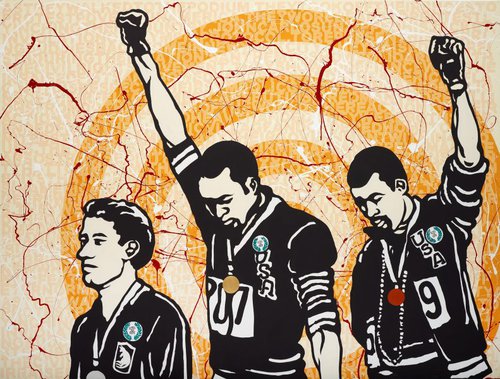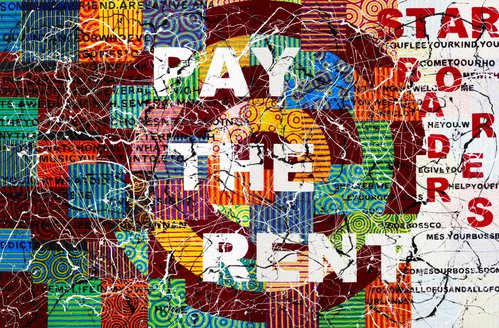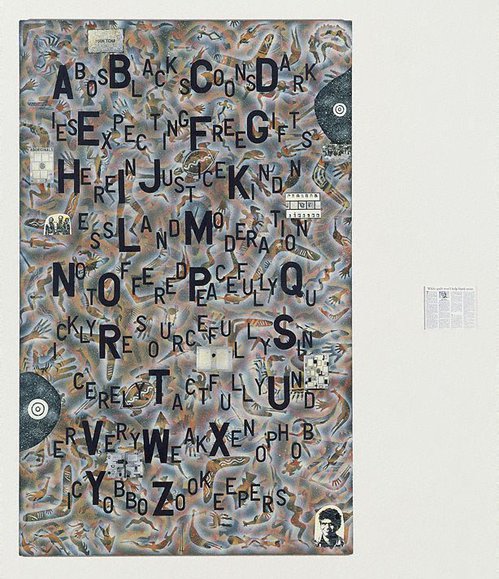Title
Pigeonholed
1992
Artist
Richard Bell
Australia
1953 –
Language groups: Kamilaroi, Northern Riverine region, Kooma, Northern Riverine region, Jiman, North-east region, Goreng Goreng, North-east region
-
Details
- Alternative title
- Pigeonholes
- Place where the work was made
-
Brisbane
→
Queensland
→
Australia
- Date
- 1992
- Media category
- Photograph
- Materials used
- 13 photographic panels on hardboard
- Dimensions
-
76.0 x 292.0 cm overall
:
a-f - six portrait panels, 50.5 x 40.3 cm, image/board, each panel
g-m - seven text panels, 20.7 x 29.5 cm, image/board, each panel
n - mirror, 50.5 x 40.5 x 0.4 cm
- Signature & date
Not signed. Not dated.
- Credit
- Purchased 1993
- Location
- Not on display
- Accession number
- 389.1993.a-n
- Copyright
- © Richard Bell, courtesy Milani Gallery, Brisbane
- Artist information
-
 Richard Bell
Richard Bell
Works in the collection
- Share
-
-
About
Richard Bell warns in the introduction to his unpublished 'Bell's Theorem' that his thesis will be '... conversational, playful, serious, tongue in cheek, moralistic, tolerant, sermonistic and informative'. Aboriginal culture, Bell believes, has become a commodity, slowly being digested by Western society. Within this system, Aboriginal artists are either 'tribal' people living in the 'outback' – whose work is fair game for appropriation – or 'urban blacks' whose cultural 'authenticity' has been disenfranchised by the brutal process of colonisation. Speaking as a member of the Murri community, Bell states, '... Our culture was ripped from us and not much remains. Most of our languages have disappeared. We don't have black or even dark skin. We don't take shit from you.' His invective is tempered by humour, however, a strategy to sugar coat the ideological pill, ensuring that his mouthful of political homily wilt stick in the throat.
Bell is a key figure in the collective of Indigenous and non-indigenous artists known as the Campfire Group, established in 1993, which evolved into the Fire-Works Gallery. The programme at their Brisbane city exhibition space claims to address 'Aboriginal Art and Other Burning Issues'. The collective's mantra is one of free artistic appropriation and influence, with the political ends justifying the artistic means. Bell, the self-proclaimed 'enfant terrible' of Australian art, wilfully uses and abuses the sacred cows of painting from Jackson Pollock to Colin McCahon , describing his role as '... very similar to Pablo Picasso'. Closer to home, Bell's paintings often make generic reference to the pictograms of rock art and desert painting. In 'Devine inspiration', 1993, a palimpsest of stencilled images and concentric circles is overwritten with an alphabet that begins with 'Abos, Blacks, Coons ...' – an 'ABC' of racist language particular to Australia. It concludes with a withering sequence of words damning the oppressors of Indigenous people as '... Very Weak Xenophobic Yobbo Zookeepers'.
Bell assaults the many fronts of Australian racism, from its most covert manifestations to everyday forms, from nursery rhymes and remarks bandied around the schoolyard to the subversive use of language. Bell highjacks language, the vehicle of Western power, and drives it headlong into the class barriers that disenfranchise minority societies. As George Petelin has written, '... Culture for [Bell] is not something of the past but part of a daily struggle'.
Hetti Perkins in 'Tradition today: Indigenous art in Australia', Art Gallery of New South Wales, Sydney, 2004
© Art Gallery of New South Wales
-
Places
Where the work was made
Brisbane
-
Exhibition history
Shown in 6 exhibitions
The boundary rider: 9th Biennale of Sydney, Bond Stores 3/4, Sydney, 15 Dec 1992–14 Mar 1993
Recent Acquisitions of Aboriginal Art, Art Gallery of New South Wales, Sydney, 05 Jul 1993–12 Sep 1993
Another Country, Art Gallery of New South Wales, Sydney, 04 Jul 1999–02 Apr 2000
Half light: portraits from black Australia, Art Gallery of New South Wales, Sydney, 21 Nov 2008–22 Feb 2009
Home: Aboriginal Art from NSW, Art Gallery of New South Wales, Sydney, 09 Jun 2012–02 Dec 2012
QUEEN’S LAND: BLACK PORTRAITURE: From late 19th century to the present, Cairns Art Gallery, Cairns, 17 May 2019–11 Aug 2019
-
Bibliography
Referenced in 5 publications
-
Anthony Bond OAM and Yvonne Kennedy, The boundary rider: 9th Biennale of Sydney, Sydney, 1992. This work is part of the 'Campfire group'
-
Hannah Fink, One sun one moon: Aboriginal art in Australia, ‘Self-evident: Indigenous artists and the photographic image’, pg. 310-321, Sydney, 2007, 311, 312-313 (colour illus.).
-
Hetti Perkins, Art + soul: a journey into the world of Aboriginal art, 'Bitter + Sweet', pg. 174-239, Carlton, 2010, 210-211 (colour illus.), 281.
-
Hetti Perkins and Jonathan Jones (Editors), Half light: Portraits from black Australia, 'Richard Bell', pg.40-47, Sydney, 2008, 44-47 (colour illus.). titled 'Pigeon Holed'
-
Hetti Perkins, Tradition today: Indigenous art in Australia, 'Richard Bell', pg. 26, Sydney, 2004, 26 (illus.).
-



